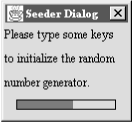SeederDialog
Wouldn’t it be nice if there were
a modal dialog that used a Seeder to generate a
seed value? And wouldn’t it be nice if the dialog had a
progress bar that showed how far along the generation was? I’ll
develop this nice dialog now.
SeederDialog is designed to make it easy to
integrate Seeder into your application. Create
one, show it, and retrieve the seed value as follows:
SeederDialog sd = new SeederDialog(this, 20); sd.show(); byte[] seed = sd.getSeed();
The dialog itself is shown in Figure 4.1. As the user types characters, the progress bar fills up. When the seed is fully generated, the dialog goes away.
SeederDialog is both an
ActionListener and a
KeyListener. It receives an
ActionEvent from its Seeder
when the seed is fully generated. It receives the same
KeyEvents as the Seeder, which
allows it to update the progress bar.
package oreilly.jonathan.awt;
import java.awt.*;
import java.awt.event.*;
import oreilly.jonathan.util.*;
public class SeederDialog
extends Dialog
implements ActionListener, KeyListener {Internally, the dialog contains a Seeder object
and a progress bar. (The progress bar is type
oreilly.jonathan.awt.ProgressBar. I’ll
present the code at the end of this section.)
ProgressBar mProgressBar; Seeder mSeeder;
SeederDialog’s constructor accepts a parent
Frame and a number of seed bytes. It creates
itself as a modal dialog (true in the call to
super()) and uses the
setupWindow()
method to configure the dialog.
public SeederDialog(Frame parent, int seedBytes) {
super(parent, "Seeder Dialog", true);
setupWindow(seedBytes);
}The getSeed()
method returns the seed
value from the underlying Seeder object.
public byte[] getSeed() { return mSeeder.getSeed(); }The dialog receives an ActionEvent from the
Seeder when it is done. In this case, it simply
shuts itself down.
public void actionPerformed(ActionEvent ae) { dispose(); }
SeederDialog receives the same
KeyEvents that are sent to the
Seeder. They are used to set the current level of
the progress bar.
public void keyPressed(KeyEvent ke) {}
public void keyReleased(KeyEvent ke) {}
public void keyTyped(KeyEvent ke) {
mProgressBar.setLevel(mSeeder.getCurrentBitIndex());
}
Finally, the
setupWindow()
method configures the user interface of
the dialog and wires up the event handling.
protected void setupWindow(int seedBytes) {
setFont(new Font("TimesRoman", Font.PLAIN, 12));
setLayout(new GridLayout(4, 1));
Label t1 = new Label("Please type some keys");
Label t2 = new Label("to initialize the random");
Label t3 = new Label("number generator.");
add(t1);
add(t2);
add(t3);
mProgressBar = new ProgressBar();
Panel p = new Panel();
p.add(mProgressBar);
add(p);
setSize(200, 200);
setLocation(100, 100);
pack();
mSeeder = new Seeder(seedBytes);
mProgressBar.setMaximum(mSeeder.getBitLength());
mSeeder.addActionListener(this);
t1.addKeyListener(mSeeder);
t1.addKeyListener(this);
t1.requestFocus();
}
}As promised, here is the code for the progress bar that
SeederDialog uses.
package oreilly.jonathan.awt;
import java.awt.*;
public class ProgressBar
extends Canvas {
int mLevel;
int mMaximum;
Color mFrameColor;
public ProgressBar() { this(100); }
public ProgressBar(int max) {
setForeground(Color.blue);
mFrameColor = Color.black;
setMaximum(max);
setLevel(0);
}
public void setMaximum(int max) {
mMaximum = max;
repaint();
}
public void setLevel(int level) {
mLevel = (level > mMaximum) ? mMaximum : level;
repaint();
}
public void update(Graphics g) { paint(g); }
public void paint(Graphics g) {
Dimension d = getSize();
double ratio = (double)((double)mLevel / (double)mMaximum);
int x = (int)((double)d.width * ratio);
g.setColor(mFrameColor);
g.drawRect(0, 0, d.width - 1, d.height - 1);
g.setColor(getForeground());
g.fillRect(1, 1, x, d.height - 2);
g.setColor(getBackground());
g.fillRect(x + 1, 1, d.width - 2 - x, d.height - 2);
}
public Dimension getMinimumSize() { return new Dimension(10, 1); }
public Dimension getPreferredSize() { return new Dimension(100, 10); }
}
Get Java Cryptography now with the O’Reilly learning platform.
O’Reilly members experience books, live events, courses curated by job role, and more from O’Reilly and nearly 200 top publishers.


